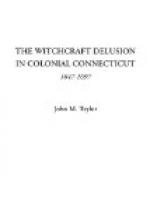An accusation of witchcraft was a serious matter, one of life or death, and often it was safer to become an accuser than one of the accused. Made in terror, malice, mischief, revenge, or religious dementia, or of some other ingredients in the Devil’s brew, it passed through the stages of suspicion, espionage, watchings, and searchings, to the formal complaints and indictments which followed the testimony of the witnesses, in their madness and delusion hot-foot to tell the story of their undoing, their grotesque imaginings, their spectral visions, their sufferings at the hands of Satan and his tools, and all aimed at people, their neighbors and acquaintances, often wholly innocent, but having marked personal peculiarities, or of irregular lives by the Puritan standard, or unpopular in their communities, who were made the victim of one base passion or another and brought to trial for a capital offense against person and property.
Taking into account the actual number of accusations, trials, and convictions or acquittals, the number of witnesses called and depositions given was very great. And the later generations owe their opportunity to judge aright in the matter, to the foresight of the men of chief note in the communities who saw the vital necessity of record evidence, and so early as 1666, in the General Court of Connecticut, it was ordered that
“Whatever testimonies are improved in any court of justice in this corporation in any action or case to be tried, shall be presented in writing, and so kept by the secretary or clerk of the said court on file.”
This preliminary analysis brings the searcher for the truth face to face with the very witnesses who have left behind them, in the attested records, the ludicrous or solemn, the pitiable or laughable memorials of their own folly, delusion, or deviltry, which marked them then and now as Satan’s chosen servitors.
Among the many witnesses and their statements on oath now made available, the chief difficulty is one of selection and elimination; and there will be presented here with the context some of the chief depositions[F] and statements in the most notable witchcraft trials in some of the Connecticut towns, that are typical of all of them, and show upon what travesties of evidence the juries found their verdicts and the courts imposed their sentences.
[Footnote F: The selected testimonies herein given are from the Connecticut and New Haven colonial records; from the original depositions in some of the witchcraft cases, in manuscript, a part of the Wyllys Papers, so called, now in the Connecticut State Library; and from the notes and papers on witchcraft of the late Charles J. Hoadley, LL.D., compiler of the colonial and state records, and for nearly a half century the state librarian.]
KATHERINE (KATERAN) HARRISON
At a Court of Assistants held at Hartford May 11, 1669, presided over by Maj. John Mason—the conqueror of the Pequots—then Deputy Governor, Katherine Harrison, after an examination by the court on a charge of suspicion of witchcraft, was committed to the common jail, to be kept in durance until she came to trial and deliverance by the law.




